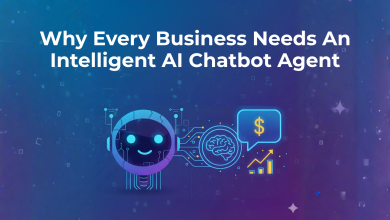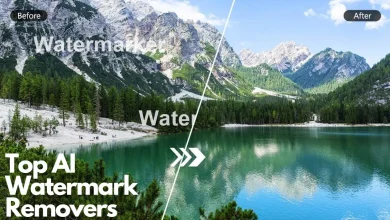
Vishal Chaurasia builds AI-enhanced data platforms that help businesses extract insights from large datasets. As a Software Development Engineer II, he integrates machine learning into data workflows at specific points where it adds value: query validation, anomaly detection, and schema monitoring. His approach focuses on augmenting existing systems rather than replacing them.
In this interview, Chaurasia explains how he selects which parts of data workflows benefit from AI automation, discusses his transition from traditional software engineering to AI-focused roles, and shares his perspective on multi-agent systems that could handle data validation and quality checks. He also offers practical advice for international students entering the AI and data engineering field.
1. What does “AI-driven automation for data workflows” mean, and why is it becoming so critical for many companies?
To me, AI-driven automation in data workflows doesn’t replace end-to-end pipelines; it augments the parts that benefit most from intelligence. By integrating ML/LLMs into specific stages, such as PII detection, schema drift alerts, query validation, and anomaly monitoring, the workflow becomes more intent-driven and adaptable, without requiring the removal of existing orchestration. That adaptability matters because data volume and compliance change faster than teams can hand-tune jobs. Targeted automation enables us to respond to change safely, adding checks, routing approvals, and suggesting fixes while maintaining the core tools, schedules, and ownership.
2. You’ve transitioned from blockchain technology to AI-enhanced data engineering. What drove that shift, and how did your blockchain experience inform your approach to AI systems?
I’ve never been fixated on a single technology. Working with blockchain pushed me deep into distributed systems and taught me why traceability and verifiability matter at every step. Those habits stuck even when I’m not using a specific DLT (distributed ledger technology). I design for immutable audit logs, idempotent jobs, and versioned data and artifacts so results are reproducible. I transitioned into AI-enhanced data engineering to address recurring issues I was encountering: quality drift, expensive query failures, and rapidly changing policy requirements, where AI offers greater leverage. The thought process remains the same: design for clarity and control with clear checks, policy, and budget guardrails, and painless rollbacks. The goal is to achieve a scalable impact without surprises, while augmenting existing pipelines rather than replacing them.
3. You work with massive sensitive datasets that businesses rely on for critical decisions. How do you ensure AI-driven data pipelines remain both scalable and trustworthy when handling such sensitive information?
I utilize AI as a peripheral aid to existing pipelines, rather than as the core engine. It appears at specific stages (query validation, anomaly flagging, and intent classification) to make workflows smarter, while the underlying platform remains stable and well-governed.
For trust, I keep it simple:
- Minimized access: least privilege, tightly scoped, time-bound credentials.
- Comprehensive logging & auditing: capture inputs, outputs, and context for every AI-assisted action so decisions are fully traceable.
- Evals as gates: run offline evaluations (accuracy, drift, bias/safety) and limited online tests with clear thresholds; don’t promote changes if they fail.
- Careful rollouts: first test new changes in parallel to compare results without impact; then release to a small, low-risk slice and automatically roll back if key metrics slip.
For scale, I treat AI components like critical services: modular, microservice-oriented pieces with clear APIs; stateless where possible; event queues to handle backpressure; autoscaling constrained by cost budgets; and explicit objectives for freshness and latency backed by robust monitoring.
4. You mentioned building platforms that enable businesses to query and extract data according to their specific needs. Can you provide a real-world example of how this AI-enhanced system operates in practice?
In self-serve analytics, free-form input can trigger costly failures, such as unbounded scans, missing joins, or plain syntax errors that waste compute and return cryptic messages. To prevent that, I built an AI-assisted SQL validator that sits before execution. It runs two passes: a deterministic check for syntax and platform guidelines (naming, join keys, time windows, partition filters), followed by a lightweight agent that interprets errors and suggests concrete fixes. Only queries that pass are submitted for processing; others return an actionable message. Result: far fewer failed runs, lower spend, and much faster turnaround. Teams get exactly the dataset they intended, safely and without waiting on engineering.
5. What advice would you give to international students looking to break into AI and data engineering roles in America?
Mastering the basics is non-negotiable: fluent SQL and Python, solid data modeling, one big-data engine, and one cloud. The fastest way to stand out in the current market is to build small, targeted projects that solve a real problem, with clean READMEs, tests, and a short cost/architecture note; they sharpen your skills and double as a public showcase of judgment. Pair that with intentional networking, share short write-ups, give 5-minute lightning talks, and ask for focused 15-minute chats and consistent open-source contributions: micro-PRs, docs fixes, test cases, and issue triage. These visible, reviewable signals prove you can collaborate, ship reliable code, and add value from day one.
6. Your expertise spans AI automation, big data analytics, and cloud infrastructure. How do you see these three areas converging to change how enterprises handle data in the next few years?
I see AI and cloud converging along three fronts. First, costs become automated: AI-driven FinOps loops watch spend in real-time, predict overruns, and trigger safe optimizations, including right-sizing, spot/on-demand shifts, and smarter partitioning. Second, cloud is the AI workbench: managed vector stores, serverless GPUs/CPUs, and governed data services make it straightforward to build, deploy, and scale AI-powered data solutions. Third, analytics gets more dynamic: big data remains the raw material, but AI now handles cleaning, segmentation, and anomaly detection, moving teams from brittle, hard-coded rules to prompt-driven, adaptive workflows that adjust as patterns change. The result? Taster iteration, lower waste, and decisions you can verify.
7. What are the biggest misconceptions companies have when trying to implement AI-driven automation in their existing data workflows, and how do you help them avoid common pitfalls?
Often, the most significant hurdles stem from common misconceptions about what AI can and can’t do.
One of the most common mistakes is viewing AI as a kind of magic bullet that can solve complex business problems on its own. Companies can get so focused on the technology that they forget first to define a clear, specific problem they’re trying to solve. When you don’t have a defined purpose, the AI becomes a solution in search of a problem, and the project often stalls out after an initial pilot. To avoid this, it’s crucial to start small and focus on a single, measurable goal. That way, you can prove the value of the AI before scaling up your efforts.
Even with a clear plan, many teams underestimate the importance of data. It’s a classic case of “garbage in, garbage out.” Teams assume that using a sophisticated model can fix or work around messy, incomplete, or inconsistent data. But an AI is only as good as what it’s trained on, and feeding it flawed data will inevitably lead to biased or unreliable results. Before even considering which model to use, it is important to ensure that the data is clean, standardized, and ready for practical use.
Lastly, there’s the misconception that implementing AI is a one time project. In reality, AI systems are not static; they require ongoing maintenance and care. The world changes, and so does your data, which can lead to performance and accuracy decay over time if left unchecked. Constant monitoring, regular retraining with new data, and an ongoing feedback loop are needed to ensure the system remains relevant and valuable long after its initial deployment.
8. You’re currently pursuing an O-1A visa, which recognizes extraordinary ability. How has building AI-enhanced developer tools and scalable data systems positioned you as a leader in this space?
I don’t build new AI models every day; I enhance existing data and analytics platforms to make them smarter, safer, and faster. My focus is on integrating AI where it proves value, for example, an AI-assisted SQL validator that catches cost-heavy mistakes before jobs run, plus orchestration APIs that spin up and monitor large EMR workloads with built-in quality, privacy, and cost controls. Coupled with observability dashboards and data contract/lineage practices, this work has meaningfully reduced failed runs and compute waste, and shortened the time-to-insight gains that teams feel immediately.
What positions me as a leader is that I turn hard-won lessons into standards and community values. I’ve been invited to judge Citrus Hack 2025 and HackForMental 2025, and I’ve served as a technical reviewer for Manning Publications on books like Think Distributed Systems, Elegant Data Pipelines, and others, which reflects trust in my judgment. Inside teams, I document patterns, mentor engineers, and ensure AI is added only where it’s accountable and auditable.
9. What skills or mindset shifts were most important when transitioning from traditional software engineering to specialized AI roles?
Software engineering and AI are intertwined, the most importan aspect is the problem itself. Before selecting an LLM, I validate whether automation is warranted and quantify the benefits, including errors avoided, time saved, and cost reduced. Modern frameworks enable anyone to develop and ship out features using AI, what separates practitioners is problem selection and integration: choosing the right use cases and designing modular, API-first components that seamlessly integrate into existing workflows, preserving privacy, governance, and reliability. The bar is simple: easy to adopt, auditable end-to-end, and delivering measurable business outcomes without breaking the product’s current rhythm.
10. What emerging trends in AI and data engineering do you think will be most transformative for how businesses process and act on data over the next decade?
Over the next decade, the most transformative change will be agentic data platforms: AI agents that handle the unglamorous work, i.e., data validation, cleaning, deduplication, and basic lineage checks, so issues are caught before compute is spun up. Layered on top, multi-agent collaboration turns pipelines into multi-step, self-checking workflows: one agent proposes a fix, another verifies against data contracts and privacy rules, a third evaluates cost and performance, and only then does the job advance. This orchestration enables teams to ship features much faster with fewer handoffs. It also unlocks fast experimentation, enabling prompt-driven mini-POCs in safe sandboxes with versioned prompts and rapid A/B Testing, so use cases can be validated in days, not quarters. None of this scales without AI observability: end-to-end telemetry for data quality, prompts, model outputs, latency, cost, drift, and provenance that makes every automated action explainable and auditable. Together, these four trends make data platforms both faster and more accountable.
11. What’s your advice for building expertise in AI-driven automation while also developing the business acumen to understand real-world applications?
Not everything needs AI. The first step in AI-driven automation is diagnostic, not technical: understand the workflow, talk to users, quantify the pain (errors, delays, costs), and only automate where there’s repeatable, measurable value. Start small, add clear guardrails (data quality, privacy, auditability), instrument outcomes in dollars and time, and be willing to kill or pivot if the impact isn’t there. That’s how you build real expertise and business acumen by proving value, not just deploying models.




